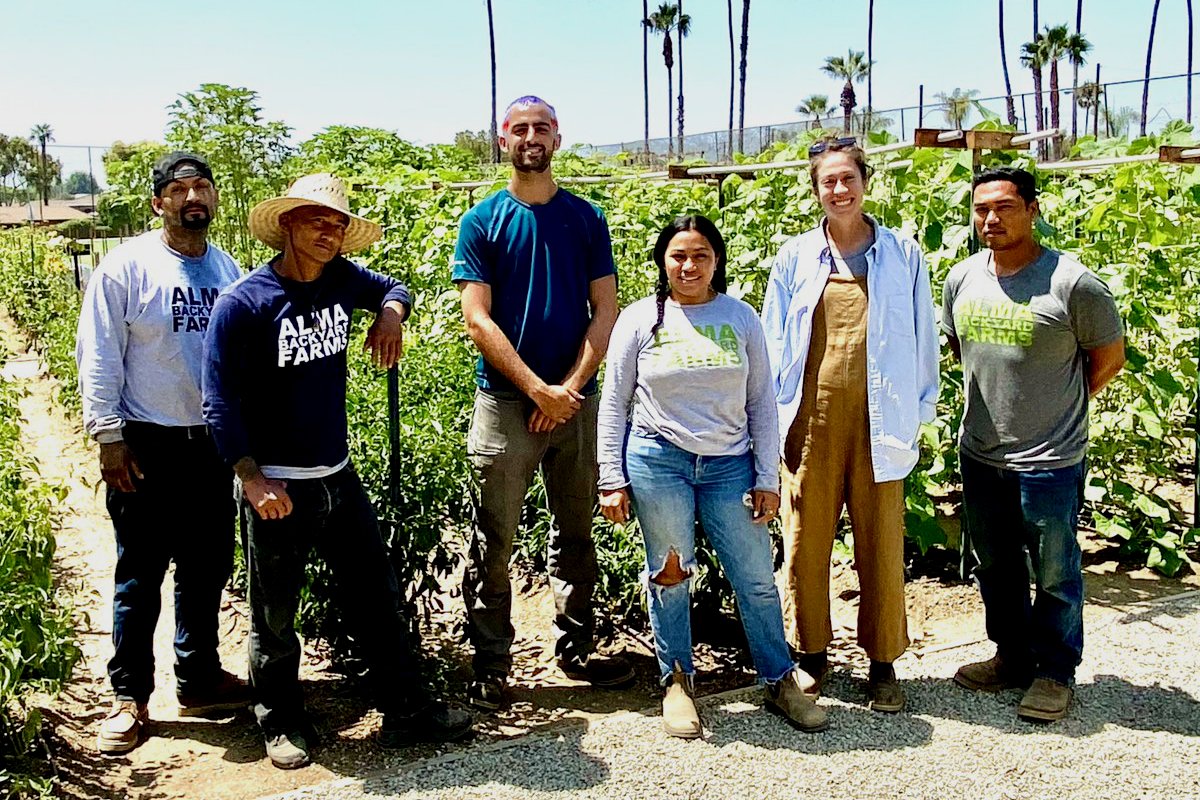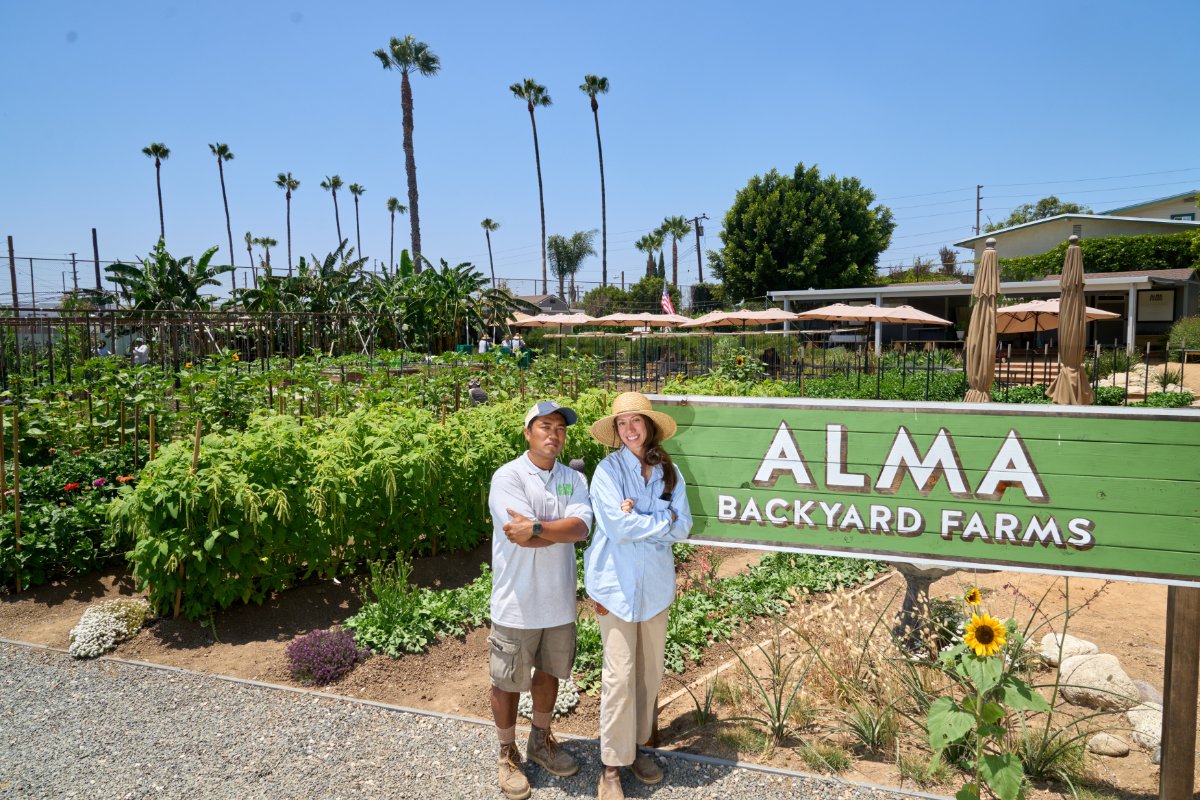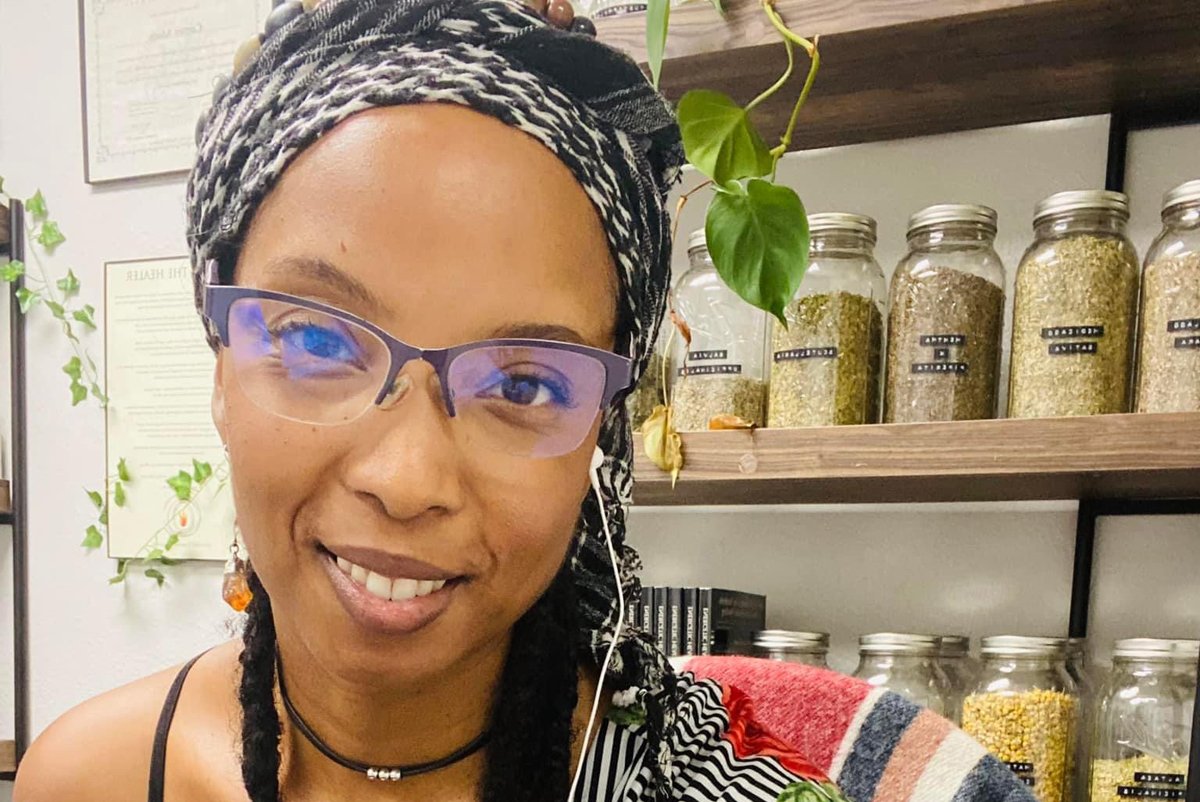After a road trip touring farms around the country, our report provides a snapshot of how three innovative, resilient urban farms are fighting food insecurity and building connections with neighbors.

After a road trip touring farms around the country, our report provides a snapshot of how three innovative, resilient urban farms are fighting food insecurity and building connections with neighbors.
November 10, 2022

At far right, urban farmers Richard Garcia and Erika Cuellar, the founders of Alma Backyard farms, with some of their crew. (Photo credit: Rachel Surls)
At a tiny farm on a busy corner in Birmingham, Alabama, an older woman, just off work, stopped to speak with farmers Chris Gooden and Maria Dominique Villanueva. She quietly told them that she was out of food, but felt too ashamed to go to the food bank. After reassuring her, they loaded the visitor up with vegetables from the farm, along with donated bread and bananas.
This, Villanueva said, is why they do this work, because people should not have to feel embarrassed when they need food. Their farm, Fountain Heights Farms, has become an oasis that feeds not only Gooden and Villanueva’s family of five, but the larger community as well. Made up of three adjacent vacant lots, and once an eyesore that included a burned-out house, this spot is one of many urban farms that have popped up around the country over the past decade. Like Fountain Heights Farms, many of these small operations have set out to offer fresh, healthy food in underserved neighborhoods.
By all appearances, it seems that there are a growing number of urban farms, from market gardens in once-vacant lots to rooftop farms, sprouting amidst concrete cityscapes. However, quantifying this apparent growth is another thing entirely: In fact, it’s unclear how many farms exist within U.S. cities. Although the U.S. Department of Agriculture (USDA) counts farms every five years through its Census of Agriculture, it does not distinguish between rural and urban operations.
The USDA has been reluctant to count urban farms, or even define the term urban farming, but it is building an infrastructure to support urban growers. The agency launched an Office of Urban Agriculture and Innovative Production and started a related grant program due to provisions in the 2018 Farm Bill. In 2021, the agency also launched a Federal Advisory Committee for Urban Agriculture and is now in the process of organizing elected committees to support farmers in 17 urban counties.
As federal resources have begun to make their way to urban farmers, I set out to document the role that urban farms are playing in communities across the U.S. This year, I have taken a series of road trips to visit innovative farms around the country—travels which have thus far taken me to 21 farms in 11 cities.
As I’ve chatted with farmers and walked through their fields, three themes have emerged. First, many, if not most, urban farms operate as nonprofit organizations, often on a shoestring budget, led by farmers who are powerfully committed to their communities. Second, urban farmers are deeply involved with provisioning food-insecure communities—and most have made significant pivots to offer free and low-cost food during the COVID-19 pandemic. And third, urban farms promote community building that goes far beyond feeding people. They have offered a place to gather and be in the company of others during what has often been a lonely, isolating time, as well as a spark of hope for the future. The farms below illustrate these themes in three very different cities.
When Gooden and Villanueva moved into their home in the historic neighborhood of Fountain Heights in 2017, they decided to save money by planting a garden, which was unexpectedly bounteous. They had no idea that their garden was about to take over their lives, just as it was taking over their yard.
Fountain Heights was once a burgeoning middle-class Black community in this former industrial city of 200,000, where Jim Crow and the battles of the Civil Rights era are living memory for many residents. Interstate I-65 cut Fountain Heights in half in 1971, and up to a third of the population left the fragmented community. Even today, many homes are abandoned, and the neighborhood has suffered for decades from a lack of investment and basic services.

Chris Gooden and Maria Dominque Villanueva at Fountain Heights Farms in Birmingham, Alabama. (Photo credit: Rachel Surls)
“Every time we planted our front yard, we’d have enough to give away,” said Gooden. “And then she came up with this idea,” he said, nodding to Villanueva. “Why don’t we grow more, a lot more? Because there’s a need here. There’s no close by grocery stores or anything like that.”
A corner store across the street is the lone market within walking distance, and it makes most of its income on beer, wine, phone cards, and an ATM. The store’s limited selection of food includes potatoes, onions, and $7 loaves of bread.
By 2018, Gooden and Villanueva were growing food in the vacant lots next door, determined to offer healthy, affordable, fresh produce in their community. Fountain Heights Farms snowballed from there. Over time, they added a greenhouse, an aquaponics system, a washing station, and a packing shed. They sold some of what they grew, and gave the rest away to neighbors.
By spring 2020, as the harsh reality of the pandemic lockdown set it, they were already a trusted provider of food in their community, which needed them more than ever. They implemented a sliding scale CSA, where customers pay what they can for a weekly box of fruits and vegetables. Even so, many couldn’t pay, and Gooden and Villanueva donated much of their harvest, which spills unfenced to the edges of the sidewalk.
This lack of fencing is a rarity on urban farms, since even those farmers focused on offering affordable food usually want to control access to their crops. Gooden and Villanueva, however, never wanted a barrier between what they grew and their neighbors. “There was never a question of us putting up a fence,” said Villanueva. “We give the food away. It doesn’t make any sense to fence it off.”
“I don’t ever remember being this connected to my community with the kind of depth that we have because of this space.”
Villanueva showed off a newly acquired vacant lot that will soon become an urban mushroom farm, thanks to a grant from Southern SARE. As we walked, she chatted with everyone she met on the street, asking after family members and offering to host an impromptu barbeque for a neighbor’s upcoming birthday.
Even more important than the food they grow, she said, is the community that’s grown up around the farm. “This is our home, this is our neighborhood. Literally, we live next door, which is sometimes a plus and a minus. But I don’t ever remember being this connected to my community with the kind of depth that we have because of this space. People come here with grief. You know, partners, loved ones dying. People come for their mental health, and they did especially during the pandemic, when we were scared to be together. But here we could be together. That sense of community is what we’re here for.”
Five hundred miles to the northwest, across the Mississippi and through the Ozarks, lies Fayetteville, a college town of 80,000 that is home to the state’s flagship University of Arkansas. Despite its middle-class appearance, food insecurity is lurking just below the surface, especially among students and service industry workers. Even before the pandemic, as many as 38 percent of undergraduates and 47 percent of graduate students at the university were food insecure. The 14 percent food-insecurity rate in Washington County, where Fayetteville is located, reflects larger trends in Arkansas, which has the second highest rate in the nation, just behind Mississippi.
Don Bennett, the founder of Tri Cycle Farms, never imagined becoming a farmer. He bounced from job to job, fallout from years of alcoholism. On his path to recovery, he worked at a nursery and was inspired by a half-off plant sale. With the bargain vegetable seedlings, he helped a friend who was struggling with food insecurity to start a backyard garden.

Don Bennett harvests an onion in one of the fallowed plots at Tri Cycle. (Photo credit: Rachel Surls)
His friend’s situation took him by surprise. She worked two jobs but was nonetheless running out of food. Her plight was part of an awakening for Bennett, a realization that people can work hard, and even have multiple jobs, and still be unable to afford healthy food. Inspired to do more as he learned about the prevalence of hunger in Arkansas, he secured land behind his home in 2011 and started the 2-acre Tri Cycle Farms. From its inception, Tri Cycle, established as a nonprofit, was all about feeding people. Although some produce was sold, most was donated. Whatever Bennett could grow—tomatoes, peppers, collards, potatoes—helped to ensure that Fayetteville residents encountering tough times had a little extra on their tables.
By 2018, Bennett and his longtime partner and farm co-manager, Kelly Bassemier, had established a partnership with Whole Foods to recover unsold food and distribute it to food pantries. Over the next two years, Tri Cycle was a bountiful source of fresh produce, a food distribution hub, and also a community gathering place for fun foodie happenings, like Pesto Fest, Tri Cycle’s big annual event that featured cook-offs and bluegrass bands.
“We had 70 people line up to get a free plant. . . . People were so happy to get a plant. It’s not food but it brings people joy. It reminded me of the importance of what we do.”
But in early 2020, as the pandemic took hold, Tri Cycle pivoted to focus on food recovery, rescuing a total of 75 tons of food in 2021.
When I visited in March, perennial crops like walking onions and lemon balm could be found peeking out from raised beds that were vanishing amidst a sea of weeds. Though Bennett was struggling with back pain from moving pallets and boxes of rescued food, he had no regrets about putting the farm on hold.
The sense of community that once came from events like Pesto Fest now comes from food distribution events on the farm. There have been challenges, but Bennett says there’s also a deep satisfaction in the work that keeps him going. One pleasure has been hosting houseplant plant giveaways.
“We had 70 people line up to get a free plant. Everyone was wearing a mask like we asked. People were so happy to get a plant,” Bennett said. “It’s not food but it brings people joy. It reminded me of the importance of what we do.”
On the other side of the country, Compton, with a population not much larger than Fayetteville, feels more urban, embedded in the vast sprawl of metropolitan Los Angeles. Compton’s modest residential neighborhoods are mixed with autobody shops, warehouses, and fast-food chains. On a July morning, I drove down Redondo Beach Boulevard looking for the quarter-acre farm, and found it tucked behind a church and a day-glow-green artificial soccer field.
Erika Cuellar, who with her husband Richard Garcia founded Alma Backyard Farms, met me at the gate. Cuellar (pictured at top with Garcia) grew up in the neighborhood. In fact, as a 10-year-old, she played softball on the very field where she now farms.

Urban farmers Richard Garcia and Erika Cuellar, the founders of Alma Backyard farms. (Photo credit: Leroy Hamilton)
Alma, which means “soul” in Spanish, is a place of redemption, of coming home, a nonprofit organization that has its roots in community service and restorative justice. The workers are all formerly incarcerated, seeking to rebuild their lives through farming. More than 300 formerly incarcerated men and women have worked at Alma since its founding nine years ago.
“Community is incredibly important when you get out of prison,” said Cuellar. “It’s not just you come out of prison, get a job, and then you’re fine. No, you have to figure out where to ground yourself, where to find people that are going to support you in your reentry. Alma has become that community for a lot of people, where you can do something that is rewarding, and give back to the community to make sure people are nourished and fed.”
Cuellar and Garcia launched Alma in 2013, working at first in private backyards, but ultimately securing this plot of church-owned land that was previously overtaken by weeds and gophers. Over the years, they built up a clientele for Alma’s produce, with a focus on selling to chefs.

Children taking part in the education program at Alma Backyard Farms. (Photo credit: Alma Backyard Farms)
The pandemic changed everything. Restaurants closed, and the Alma team began offering curbside distribution of free food. Compton was already food insecure, and in the months of lockdown, hunger became a reality for many families. During the chaotic days of 2020, local residents could pull up at the curbside in front of the farm, and get a bag of fresh produce and donated groceries, no questions asked.
Over time, the curbside distribution program morphed into a bi-weekly farm stand, and neighbors began visiting the farm to buy vegetables, hang out, chat about food, and swap recipes. Although Alma no longer operates in actual backyards, the farm on this once-abandoned field slowly became a kind of community backyard.
The farm site has multiple uses, according to Garcia, a former seminary student turned farmer. “This was a farm stand last Sunday. For the last two weeks we’ve had a farm camp for kids, and this was our amphitheater for the campers. On some nights we’ve used it for meditation class,” he said gesturing to the farm’s ample community gathering area. “That’s part of why urban ag is so nimble. Our spaces are versatile.”
The magic of urban farms is also in the way they bring communities together, for learning, for restoring hope, for getting to know neighbors we might not otherwise meet, for healing collective trauma.
This flexibility is part of urban farms’ enduring popularity. They can be what their community needs them to be, and they can turn on a dime. Since the beginning of the pandemic, communities have needed both food and connection, and farms like Fountain Heights, Tri Cycle, and Alma have delivered both. They have also served as community resource hubs. Tri Cycle, though it fallowed its land, was positioned to become an important center for community food distribution. Alma offered a place for everything from children’s activities to a farm stand. Fountain Heights Farms, along with its food distribution, was a hub for mutual aid organizing during the worst days of the pandemic.
The magic of urban farms is also in the way they bring communities together, for learning, for restoring hope, for getting to know neighbors we might not otherwise meet, for healing collective trauma.
And they can offer an infusion of much-needed beauty. In Birmingham, Gooden and Villanueva plant some of their crops in gently curving beds that are reminiscent of a smile, or an ocean wave. “We wanted people to feel like we were pulling them in, like a hug. With production farming, straight rows, we could have gotten more food, but it’s about balancing what is beautiful with what is productive,” said Villanueva. She paused, looking gratified, surveying the yellow snapdragons and red poppies, beds of bright green lettuce, and a robust crop of tomato and pepper seedlings, in her corner of Fountain Heights.

September 4, 2024
By paying top dollar for milk and sourcing within 15 miles of its creamery, Jasper Hill supports an entire community.
September 3, 2024

August 27, 2024

August 26, 2024

August 13, 2024

Like the story?
Join the conversation.